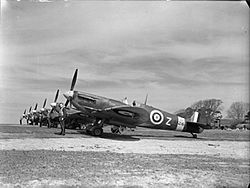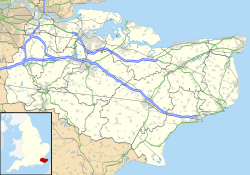RAF Hawkinge facts for kids
Quick facts for kids RAF Hawkinge
|
|||||||
|---|---|---|---|---|---|---|---|
| Hawkinge, Kent in England | |||||||

Spitfire Mk Vs of No. 91 Squadron lined up at Hawkinge during May 1942
|
|||||||
|
Shown within Kent
|
|||||||
| Coordinates | 51°06′45″N 001°09′09″E / 51.11250°N 1.15250°E | ||||||
| Type | Royal Air Force station | ||||||
| Code | VK | ||||||
| Site information | |||||||
| Owner | Air Ministry | ||||||
| Operator | Royal Flying Corps (1915–1918) Royal Air Force (1918–1962) |
||||||
| Controlled by | RAF Fighter Command 1940-62 | ||||||
| Site history | |||||||
| Built | 1915 | ||||||
| In use | October 1915 - January 1962 | ||||||
| Fate | Site redeveloped for housing estate and museum | ||||||
| Battles/wars | First World War European theatre of World War II |
||||||
| Airfield information | |||||||
| Elevation | 165 metres (541 ft) AMSL | ||||||
|
|||||||
Royal Air Force Hawkinge, or RAF Hawkinge, was an important air base in England. It was located near Folkestone in Kent. This airfield was used by the Royal Flying Corps and the Royal Air Force. It played a big part in both the First World War and the Second World War. RAF Hawkinge was especially key during the Battle of Britain.
Contents
A Look Back: The History of RAF Hawkinge
Early Days: World War I
During the First World War, the airfield was first known as RFC Folkestone. This name changed to RFC Hawkinge in late 1916. Only one squadron, No. 25 Squadron RFC, was based there for a short time. They flew planes like the Vickers F.B.5 and Royal Aircraft Factory F.E.2B.
Later, a special unit called an Aircraft Acceptance Park was set up. This unit checked new aircraft. It was there from 1917 until 1919.
Between the World Wars
After the First World War, many different squadrons used RAF Hawkinge. They flew various types of aircraft. These included the Hawker Audax, Hawker Hector, and Westland Lysander. Fighter planes like the Sopwith Snipe and Gloster Gladiator were also based here.
Squadrons would often move to different bases. For example, 25 Squadron RAF was at Hawkinge several times. They flew the Snipe, then the Bristol Blenheim IF.
World War II and the Battle of Britain
RAF Hawkinge was very important during the Second World War. It helped keep contact between the Royal Air Force and British troops in France. This was especially true during the Battle of France and the Dunkirk evacuation in 1940.
The airfield was a key base for fighter planes during the Battle of Britain. German bombers attacked it heavily. The damage was so bad that the base had to be closed for a while.
Many brave airmen who died during the war are buried nearby. Most of them were killed during the Battle of Britain. There are also German graves in the cemetery.
Squadrons During World War II
Many different RAF squadrons operated from Hawkinge during the war. They flew famous planes like the Hawker Hurricane and the Supermarine Spitfire. These squadrons helped defend Britain from enemy attacks. Some examples include:
- 1 Squadron RAF with the Hurricane I.
- 41 Squadron RAF with the Spitfire VB and XII.
- 91 Squadron RAF with the Spitfire IIA and VB.
- Rescue squadrons like 277 Squadron RAF also used the base. They flew planes like the Supermarine Walrus and Supermarine Sea Otter to help downed pilots.
Squadrons from other countries also used Hawkinge. These included units from Canada, Australia, Belgium, and Czechoslovakia. They all worked together to fight during the war.
After the War: Post-War Years
After the Second World War, RAF Hawkinge continued to be used. It became a place where young Air Cadets learned to fly gliders. This was at the Home Command Gliding Centre RAF. They used gliders like the Slingsby Mk III.
For a few years, from 1960 to 1962, Hawkinge was a training unit for women officers. Group Officer Jean Conan Doyle, the daughter of famous writer Sir Arthur Conan Doyle, was in charge. The gliding centre stayed open because the grass airfield was perfect for glider training.
What is There Now?
Today, most of the old RAF Hawkinge site has been built over. It is now a housing estate. However, the Kent Battle of Britain Museum is located there. This museum helps people remember the important history of the airfield and the Battle of Britain. Locals sometimes call the remaining parts of the old airfield "the rough grounds."
See also
- Battle of Britain
- List of Battle of Britain airfields
- List of Battle of Britain squadrons
- List of former Royal Air Force stations



